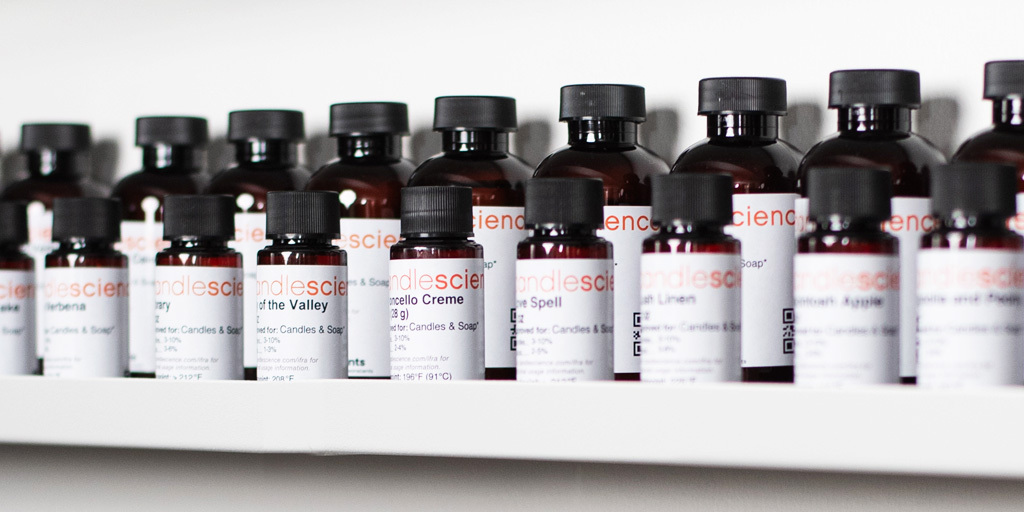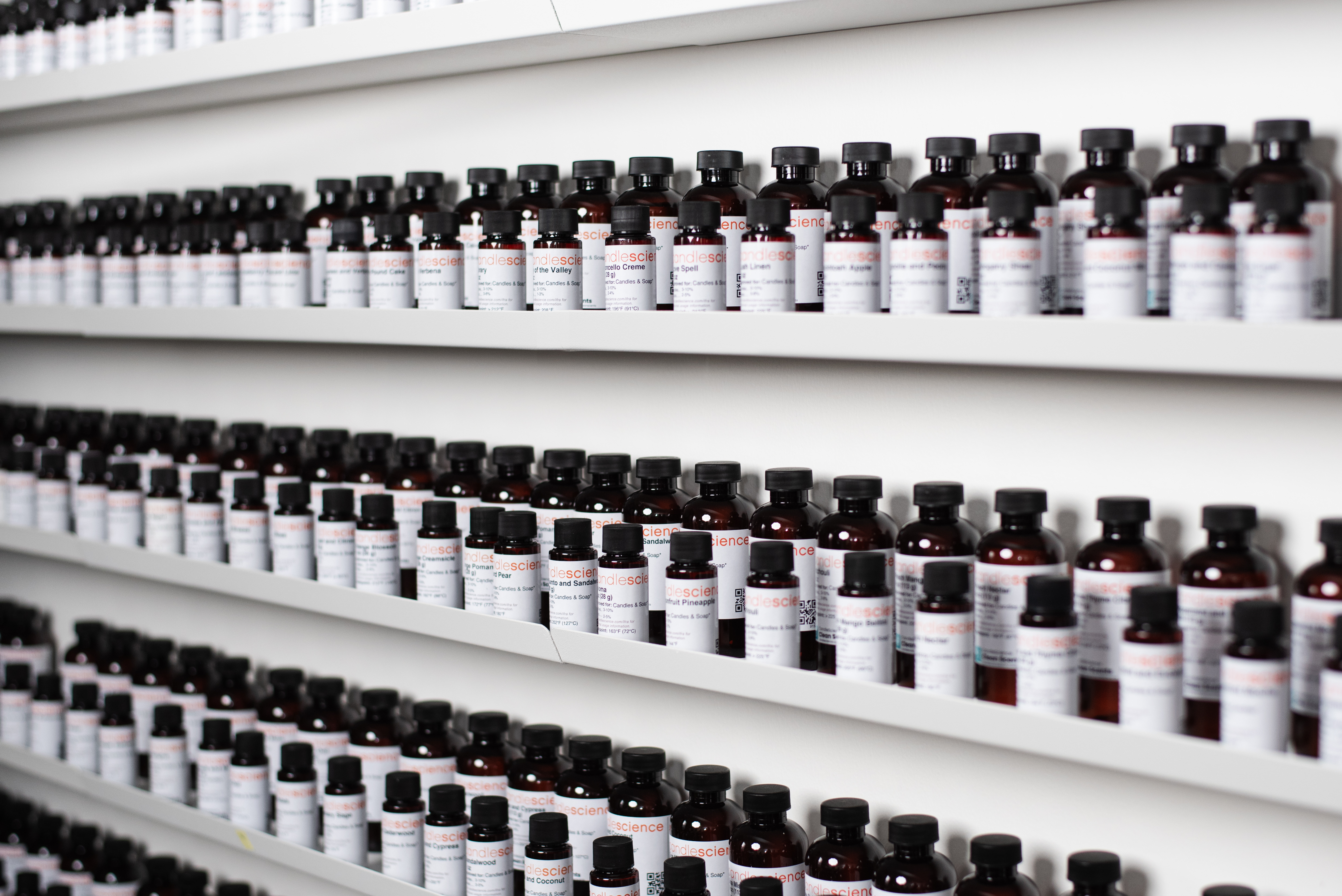How long do fragrance oils last? Plus tips for storing and managing your fragrance oil collection, and how to properly dispose of expired fragrances.

There comes a time in every candle maker’s life when they look around and realize they might have collected a few too many fragrance oils. And some of the fragrance oils may have been collecting dust for a few years. So what should you do with your fragrance oils in this case?
Since we’ve seen many makers asking online about how to tell if their fragrance oils—whether partially used or unopened—are still useable, this article covers the ins and outs of fragrance oil storage, and how to tell when fragrance oils are past their prime.
Fragrance oil shelf life and factors affecting longevity
Most fragrance oils last about one year. However, fragrance oil components vary from formula to formula and oxidize at different rates, making it tricky to give an all-encompassing recommendation for their longevity.
We’ve always recommended purchasing only enough fragrance to use within six months to a year, but we get it—you want to try all the scents! In this article, we’ll cover tips and tricks for fragrance oil storage and how to tell when fragrance oils are past their prime.
There are so many fragrance oils on the market, and every fragrance oil is composed using different raw materials. While the average shelf life of fragrance oils is about one year, some raw materials age faster than others.
So a one-year shelf life is a good average to keep in mind, but there’s no need to toss one-year-old fragrance oils out without first evaluating them.

Fragrance oil storage: best practices
Before we get into evaluating your fragrance oils, let’s first go over how to store fragrance oils. Storage conditions play a huge role in determining how long your fragrance oils last. By following the fragrance oil storage best practices outlined here, you’ll help your fragrance oils last for as long as possible.
- Keep fragrance oils at room temperature. Specifically, the ideal storage temperature range is 65°F to 85°F (18.3°C to 29.4°C). Fragrance oils can crystallize at lower temperatures, so we don’t recommend refrigeration.
- Avoid extreme temperature changes. Garages, attics, basements, or backyard sheds are the first place many people think to store their excess fragrance oils. But unless yours is temperature-controlled, it’s best to find another place! Extreme temperature changes can shorten the life of your fragrance oils, so it’s important to store them in an area that maintains a constant room temperature between 65°F and 85°F.
-
Store fragrance oils in a dark area, away from direct sunlight. Sunlight can speed up the degradation rate of certain components, so minimizing excess light exposure will help extend the life of your fragrance oils. Some simple ways to accomplish this include keeping them in a windowless closet or room and opting for opaque storage boxes that don’t allow light to shine through.
Most trustworthy fragrance oil suppliers use opaque or amber bottles, which help protect against light rays. However, storing your oils in a dark area provides an extra layer of protection. If your fragrance oil bottles are clear, it’s even more crucial to store them in a dark area. -
Record the “opened-on” date. Once oxidation starts, it can continue without further exposure to air. By recording the date that you first open your fragrance oils, you can easily keep track of how long oxidation has been a risk factor.
Writing down the date you open your fragrance oils can also go a long way in managing your collection. Some makers simply write the date of opening on the fragrance oil bottle, while others prefer using a spreadsheet or written list.

.jpg)
Signs of fragrance oil expiration
Now that you’re familiar with the best practices for storage, let’s discuss how to determine when fragrance oils have gone bad.
Changes in color: A noticeable color change can indicate that fragrance oil components have oxidized or degraded. You need to know the base color to notice a color change, so taking a photo of it the first time you open it can help you keep track. When you record the opened-on date of your fragrance oils, consider noting the color of them as well.
To check the color of fragrance oils stored in dark or opaque bottles, dip a fragrance blotter strip into the oil or pour the fragrance oil into a small beaker.
Shift in scent: Scent shift is another indicator that your fragrance oils are no longer useable. If your fragrance oils smell different than you remember, rancid, or sour, it’s likely gone bad.
If it's hard to tell, get a friend or family member to give you a second opinion. Candle and soap makers can develop olfactory fatigue from working with the same scent for a long period of time. A second opinion is often very helpful when determining if you should keep or toss older fragrance oils.
Test batch performance: Making a test batch is the best way to tell for certain if your fragrance oils are still viable. Make a candle or soap using the fragrance oil in question, let it cure, then test it.
If you notice the color or scent of your final product is different than expected, it’s probably time to move your fragrance oil to the discard pile. If it’s looking, smelling, and performing as normal, then it’s safe to assume your fragrance oil is still good to use!
Fragrance oil disposal
Even the most organized candle and soap makers occasionally have fragrance oil they need to dispose of. But it’s important to dispose of fragrance oil responsibly!
Waste management and recycling programs vary depending on your location. Since fragrance oil disposal regulations aren’t the same for all makers, it’s important to know how to look up the regulations that pertain to you. Most municipalities make this easy, though!
To learn how to responsibly dispose of fragrance oil, do an online search for the name of your location and the term hazardous waste disposal. Most waste management programs publish online instructions pertaining to the disposal of various types of hazardous waste, but you can also call the phone number for waste management if you can’t find them online.
Many waste management programs instruct you to leave liquids in their labeled containers before disposing of them, but some areas have different requirements. Always check in with your local waste management center before emptying fragrance oils out of the containers.
And if you have fragrance oils that aren’t expired but you know you won’t use them, try offering them to local candle making or buy-sell-trade groups!
Waste management organizations use the term hazardous waste to refer to materials that might harm humans, animals, or the environment if disposed of improperly. Some popular materials that fall into this category include household cleaners, paints, cooking oil, batteries, and electronics.
Materials classified as hazardous waste aren't necessarily hazardous, but waste management facilities do need to dispose of them in specific ways. Proper disposal of hazardous waste is important because it helps prevent air, water, and soil pollution.
Final thoughts
The fragrance oil collections of candle and soap makers tend to grow exponentially—most of us get into making for the love of fragrance! But keeping your fragrance oil collection organized as it grows will help avoid unnecessary stress down the road.